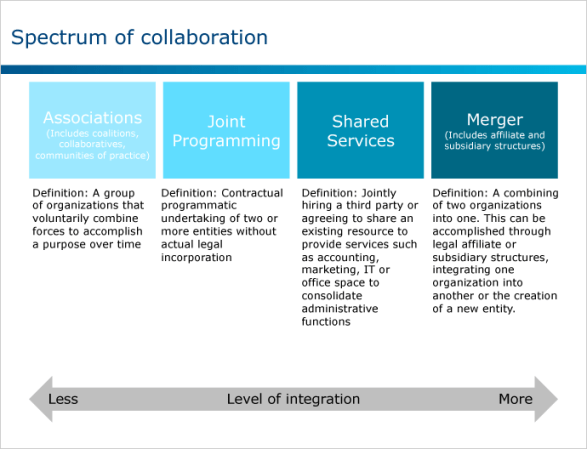Partnerships and collaboration are strategic alliances between nonprofits that are intended to achieve greater impact than any organization could generate on its own. These alliances exist along a broad spectrum of approaches, ranging from less integrated associations and coalitions to more highly integrated joint programming, shared services, and legal mergers.
How it's used
Strategic alliances can be used by nonprofits for several purposes, typically relating to increasing their influence, scaling up their efforts, strengthening and expanding their programs and services, or streamlining operations to gain efficiencies. In particular, organizations can use collaborations to:
- Achieve greater leverage among stakeholders, e.g. build awareness or advocacy
- Address complex issues that require coordinating multiple stakeholders
- Provide an integrated continuum of services to meet beneficiaries' needs
- Strengthen or expand program or service quality and performance
- Gain back-office or administrative efficiencies
- Achieve greater economies of program scale
- Enter new geographies, provide new services, or reach new beneficiaries

There are many contractual forms that strategic alliances can take on, such as:
- Associations, coalitions and collective impact collaborations, which work together to accomplish a shared purpose over time
- Joint programming, including referral relationships
- Shared services and back office support
- Merger, re.g.legally combining two organizations into one or creating legal subsidiaries
Methodology
While strategic alliances are complex and do not all look alike, there are five general steps to the process:
- Determine one's own strategic needs and what is desired from a collaboration: The impetus for any collaboration should be strategic benefits that can only be realized through an alliance or partnership. Gather key stakeholders to determine whether areas of the organization's strategic plan or intended impact and theory of change would be enhanced by collaboration, and what level of integration and length of partnership are required to achieve the impact you seek.
- Identify potential organizations to collaborate with, then begin conversations: Conduct a market mapping and landscape analysis to determine which peers might make potential partners
- Consider practical implementation challenges: Taking into account organizational culture and structure, strengths, weaknesses, leadership, governance, systems, and back-office support, critically consider the practical challenges of implementing an alliance. Involve key staff at the organizations to discuss the realities of their work.
- Conduct due diligence and negotiations: It is essential to go through a deep due diligence and negotiation process to ensure there are no major surprises once an agreement is reached. Make certain that all organizations involved agree with and feel comfortable with all agreements.
- Implement collaboration, adjusting as needed: Once an agreement has been reached, the organizations can implement their alliance through a memo of understanding or legal accord. Communicating openly, learning, adapting, and measuring key indicators are essential to ensuring a healthy and successful collaboration.
Related topics
Additional resources
The Partnership Matrix
La Piana Consulting, one of the thought leaders on collaboration in the nonprofit sector, explains its Partnership Matrix and outlines the various types of partnerships in which organizations can engage.
Why Nonprofit Mergers Continue to Lag
Despite growing support for nonprofit mergers, promising combinations often fall apart over three emotionally charged issues: getting the boards aligned, finding roles for senior staff, and blending the brands. Creating a due diligence process that overcomes these hurdles can increase the likelihood that a merger will succeed.
Nonprofit Mergers and Acquisitions: More Than a Tool for Tough Times
Mergers have long been seen as a way for struggling nonprofits to shore up their finances or address a leadership gap. However, mergers can also be a way for strong organizations to strengthen effectiveness, share best practices, expand reach, and—yes—save money, making best use of scarce resources.
Examples and case studies
Good Shepherd Services: Acquiring Sites and Programs
To broaden its reach and scope of services, Good Shepherd Services acquired two smaller nonprofits in 2012. The acquisitions boosted Good Shepherd Services' reputation and reach, bringing in $2.9 million in additional support to sustain the mergers.
Pine Street Inn and hopeFound: Combining Resources to Provide Long-Term Homes to the Homeless
To achieve their unified goal of efficiently providing long-term housing to the homeless in Boston, Pine Street Inn and hopeFound combined forces to make use of each other's capabilities.

